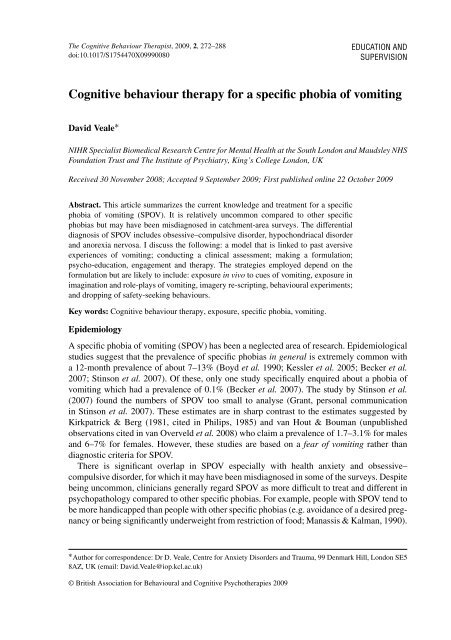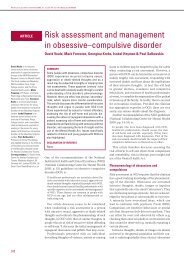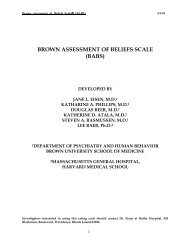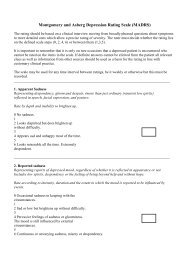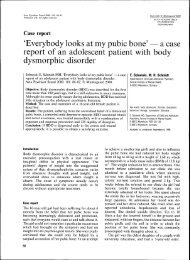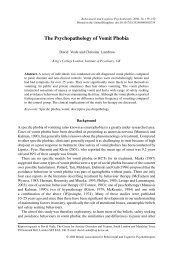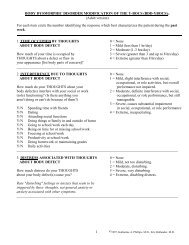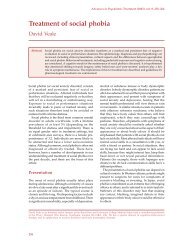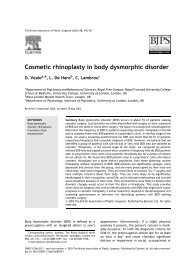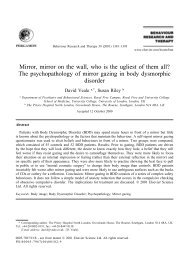Cognitive behaviour therapy for a specific phobia of vomiting
Cognitive behaviour therapy for a specific phobia of vomiting
Cognitive behaviour therapy for a specific phobia of vomiting
Create successful ePaper yourself
Turn your PDF publications into a flip-book with our unique Google optimized e-Paper software.
The <strong>Cognitive</strong> Behaviour Therapist, 2009, 2, 272–288doi:10.1017/S1754470X09990080EDUCATION ANDSUPERVISION<strong>Cognitive</strong> <strong>behaviour</strong> <strong>therapy</strong> <strong>for</strong> a <strong>specific</strong> <strong>phobia</strong> <strong>of</strong> <strong>vomiting</strong>David Veale ∗NIHR Specialist Biomedical Research Centre <strong>for</strong> Mental Health at the South London and Maudsley NHSFoundation Trust and The Institute <strong>of</strong> Psychiatry, King’s College London, UKReceived 30 November 2008; Accepted 9 September 2009; First published online 22 October 2009Abstract. This article summarizes the current knowledge and treatment <strong>for</strong> a <strong>specific</strong><strong>phobia</strong> <strong>of</strong> <strong>vomiting</strong> (SPOV). It is relatively uncommon compared to other <strong>specific</strong><strong>phobia</strong>s but may have been misdiagnosed in catchment-area surveys. The differentialdiagnosis <strong>of</strong> SPOV includes obsessive–compulsive disorder, hypochondriacal disorderand anorexia nervosa. I discuss the following: a model that is linked to past aversiveexperiences <strong>of</strong> <strong>vomiting</strong>; conducting a clinical assessment; making a <strong>for</strong>mulation;psycho-education, engagement and <strong>therapy</strong>. The strategies employed depend on the<strong>for</strong>mulation but are likely to include: exposure in vivo to cues <strong>of</strong> <strong>vomiting</strong>, exposure inimagination and role-plays <strong>of</strong> <strong>vomiting</strong>, imagery re-scripting, <strong>behaviour</strong>al experiments;and dropping <strong>of</strong> safety-seeking <strong>behaviour</strong>s.Key words: <strong>Cognitive</strong> <strong>behaviour</strong> <strong>therapy</strong>, exposure, <strong>specific</strong> <strong>phobia</strong>, <strong>vomiting</strong>.EpidemiologyA <strong>specific</strong> <strong>phobia</strong> <strong>of</strong> <strong>vomiting</strong> (SPOV) has been a neglected area <strong>of</strong> research. Epidemiologicalstudies suggest that the prevalence <strong>of</strong> <strong>specific</strong> <strong>phobia</strong>s in general is extremely common witha 12-month prevalence <strong>of</strong> about 7–13% (Boyd et al. 1990; Kessler et al. 2005; Becker et al.2007; Stinson et al. 2007). Of these, only one study <strong>specific</strong>ally enquired about a <strong>phobia</strong> <strong>of</strong><strong>vomiting</strong> which had a prevalence <strong>of</strong> 0.1% (Becker et al. 2007). The study by Stinson et al.(2007) found the numbers <strong>of</strong> SPOV too small to analyse (Grant, personal communicationin Stinson et al. 2007). These estimates are in sharp contrast to the estimates suggested byKirkpatrick & Berg (1981, cited in Philips, 1985) and van Hout & Bouman (unpublishedobservations cited in van Overveld et al. 2008) who claim a prevalence <strong>of</strong> 1.7–3.1% <strong>for</strong> malesand 6–7% <strong>for</strong> females. However, these studies are based on a fear <strong>of</strong> <strong>vomiting</strong> rather thandiagnostic criteria <strong>for</strong> SPOV.There is significant overlap in SPOV especially with health anxiety and obsessive–compulsive disorder, <strong>for</strong> which it may have been misdiagnosed in some <strong>of</strong> the surveys. Despitebeing uncommon, clinicians generally regard SPOV as more difficult to treat and different inpsychopathology compared to other <strong>specific</strong> <strong>phobia</strong>s. For example, people with SPOV tend tobe more handicapped than people with other <strong>specific</strong> <strong>phobia</strong>s (e.g. avoidance <strong>of</strong> a desired pregnancyor being significantly underweight from restriction <strong>of</strong> food; Manassis & Kalman, 1990).∗ Author <strong>for</strong> correspondence: Dr D. Veale, Centre <strong>for</strong> Anxiety Disorders and Trauma, 99 Denmark Hill, London SE58AZ, UK (email: David.Veale@iop.kcl.ac.uk)© British Association <strong>for</strong> Behavioural and <strong>Cognitive</strong> Psychotherapies 2009
Specific <strong>phobia</strong> <strong>of</strong> <strong>vomiting</strong> 273Characteristics <strong>of</strong> SPOVLipsitz et al. (2001) and Veale & Lambrou (2006) have published surveys <strong>of</strong> people with aSPOV from internet support groups. These studies suggest it commonly develops in childhoodwith a mean duration <strong>of</strong> about 25 years and occurs almost exclusively in women (<strong>for</strong> thisreason I will refer to clients in the female gender). The gender differences may be reflected inthe normal population – men may be more likely to view <strong>vomiting</strong> as a joke and even desire tovomit after heavy drinking. Most people with a SPOV are predominantly fearful <strong>of</strong> their self<strong>vomiting</strong>(Veale & Lambrou, 2006). They may also strenuously try to avoid people who theybelieve to be at risk <strong>of</strong> <strong>vomiting</strong> usually because they believe it would put themselves at risk <strong>of</strong><strong>vomiting</strong>. Even if there is no evidence that a person <strong>vomiting</strong> is contagious, such individuals area stimulus <strong>for</strong> having to think about <strong>vomiting</strong> or feeling nauseous and a client may then believethat it would cause her to vomit by a process <strong>of</strong> magical thinking. A minority <strong>of</strong> people withSPOV are either exclusively or predominantly fearful <strong>of</strong> others <strong>vomiting</strong> (usually on them), asdescribed by McKenzie (1994) and McFadyen & Wyness (1983). This might be described as asubtype <strong>of</strong> SPOV or a different <strong>specific</strong> <strong>phobia</strong>. These people may be easier to treat and shouldbe investigated separately in any controlled trial. The rest <strong>of</strong> this article there<strong>for</strong>e assumes thata client is predominantly fearful <strong>of</strong> herself <strong>vomiting</strong> (or <strong>of</strong> herself and others equally).Davidson et al. (2008) have highlighted the relationship between a heightened internallocus <strong>of</strong> control and a SPOV. This is in keeping with the experience <strong>of</strong> people with SPOVwho fear losing control and who may convince themselves that they can avoid <strong>vomiting</strong> bycontrolling a reflex response. Van Overveld et al. (2008) found that people with SPOV haveincreased levels <strong>of</strong> disgust propensity and sensitivity and that this is the best predictor <strong>of</strong>symptoms in SPOV. Boschen (2007) discussed a cognitive <strong>behaviour</strong>al model and researchagenda. He described how people with SPOV may be more vulnerable to general anxietyand somatization (a tendency to express anxiety through somatic symptoms – <strong>specific</strong>allygastrointestinal symptoms, e.g. nausea, bloating, diarrhoea, ‘butterflies’). They may havesuffered aversive experiences <strong>of</strong> themselves and others <strong>vomiting</strong>.In extreme anxiety, some people (especially children) may vomit probably through theparasympathetic vagal pathway which can also lead to immobility, fainting, dissociation anddefecation (Porges, 2007). The experience <strong>of</strong> <strong>vomiting</strong> as a child might be associated withthe feeling <strong>of</strong> suffocation or death and be a factor in the development <strong>of</strong> SPOV. Ohman &Mineka (2001) suggest that a fear module is preferentially activated in aversive contexts bystimuli that are fear relevant in an evolutionary perspective. This can include food aversionsthat have developed after <strong>vomiting</strong> and could lead to avoidance <strong>of</strong> cues related to <strong>vomiting</strong>(Garcia et al. 1977). Such aversions are extremely enduring and this is a probable factor inthe development <strong>of</strong> a SPOV. Ohman & Mineka (2001) also suggest that activation to suchstimuli is automatic and is relatively impenetrable to cognitive control. They suggest that afear module mediates an emotional level <strong>of</strong> fear learning that is relatively independent anddissociable from cognitive learning <strong>of</strong> stimulus relationships.DiagnosisA SPOV is relatively easy to diagnose when a client presents with a fear <strong>of</strong> <strong>vomiting</strong>. The keycriteria <strong>for</strong> a <strong>specific</strong> <strong>phobia</strong> in DSM-IV (APA, 2000) are given in Table 1. The words in italicsabout <strong>vomiting</strong> have been added to the relevant criteria. DSM-IV classifies SPOV as SpecificPhobia ‘Other type’ which may have the unintended effect <strong>of</strong> minimizing research into SPOV(Boschen, 2007).
274 D. VealeTable 1. Key criteria <strong>for</strong> <strong>specific</strong> <strong>phobia</strong> <strong>of</strong> <strong>vomiting</strong>(a) Marked and persistent fear <strong>of</strong> <strong>vomiting</strong> that is excessive or unreasonable, cued by the presence <strong>of</strong>vomit or anticipation <strong>of</strong> <strong>vomiting</strong>.(b) Exposure to cues related to <strong>vomiting</strong> almost invariably provokes an immediate anxiety response,which may take the <strong>for</strong>m <strong>of</strong> a situationally bound or situationally pre-disposed panic attack.(c) The person recognizes that the fear <strong>of</strong> <strong>vomiting</strong> is excessive or unreasonable.(d) Phobic situations related to <strong>vomiting</strong> are avoided or else endured with intense anxiety or distress.(e) The avoidance, anxious anticipation, or distress interferes significantly with the person’s normalroutine, occupational (or academic) functioning, or social activities or relationships, or there ismarked distress about having the <strong>phobia</strong>.I first discuss the differential diagnosis <strong>of</strong> SPOV from other anxiety disorders and anorexianervosa and how they may be comorbid. It is particularly important to note the onset <strong>of</strong> acomorbid diagnosis and its functional relationship to SPOV.Hypochondriacal disorder (health anxiety)People with hypochondriacal disorder are concerned with the fear <strong>of</strong> being ill (in which thefocus <strong>of</strong> a disease <strong>of</strong>ten varies over time) rather than <strong>vomiting</strong> per se. People with SPOV<strong>of</strong>ten have a significant degree <strong>of</strong> health anxiety in that they worry about infections or foodpoisoning that may cause them to vomit. Alternatively, they attribute the cause <strong>of</strong> nausea toa physical problem (e.g. irritable bowel syndrome, or middle ear disease) rather than anxiety.A diagnosis <strong>of</strong> a comorbid hypochondriacal disorder would be made if there were additionalfears <strong>of</strong> illness unrelated to <strong>vomiting</strong>.Obsessive–compulsive disorder (OCD)People with SPOV <strong>of</strong>ten per<strong>for</strong>m rituals or superstitious <strong>behaviour</strong>s to prevent <strong>vomiting</strong> andthese tend to develop after the SPOV. A comorbid diagnosis <strong>of</strong> OCD would be made if therewere additional obsessions and compulsions that are unrelated to rituals and an over-inflatedsense <strong>of</strong> influence over their ability to stop themselves or others <strong>vomiting</strong>.Panic disorderA diagnosis <strong>of</strong> panic disorder requires recurrent unexpected panic attacks with anticipatoryanxiety about further attacks. Sometimes the main fear <strong>of</strong> panic disorder is <strong>of</strong> <strong>vomiting</strong> whenfeeling nauseous and anxious (but this is usually in the context <strong>of</strong> other physiological sensationsand minimal avoidance <strong>of</strong> cues relating to <strong>vomiting</strong>). It is, however, still possible to have anadditional comorbid spontaneous panic attacks unrelated to a SPOV.Social <strong>phobia</strong>The majority <strong>of</strong> people with a SPOV are fearful <strong>of</strong> <strong>vomiting</strong> whether they are alone or in socialsituations (<strong>of</strong>ten equally). The embarrassment <strong>of</strong> <strong>vomiting</strong> in public may be an additionalburden <strong>for</strong> a person with a SPOV. Here the fear <strong>of</strong> others being critical <strong>of</strong> <strong>vomiting</strong> in public
Specific <strong>phobia</strong> <strong>of</strong> <strong>vomiting</strong> 275may require extra focus in <strong>therapy</strong>. People who are predominantly fearful <strong>of</strong> the embarrassment<strong>of</strong> <strong>vomiting</strong> in public situations (and are not especially fearful <strong>of</strong> <strong>vomiting</strong> when they are alone)would have a diagnosis <strong>of</strong> social <strong>phobia</strong>. Such a case is described by Lesage & Lamontagne(1985). McNally (1997) also describes an atypical social phobic who would induce <strong>vomiting</strong>if she had to leave her home unexpectedly and be<strong>for</strong>e she had fully digested a meal. Thus<strong>vomiting</strong> in the privacy <strong>of</strong> her home was better than her negative evaluation <strong>of</strong> <strong>vomiting</strong> inpublic.Other <strong>specific</strong> <strong>phobia</strong>sThe fear <strong>of</strong> choking or suffocating on vomit may be a secondary problem in SPOV. In this casethe main problem may be a <strong>specific</strong> <strong>phobia</strong> <strong>of</strong> suffocating from food lodging in the tracheaor <strong>of</strong> choking on food lodging in the oesophagus. Hypersensitivity <strong>of</strong> the gag reflex (andavoidance <strong>of</strong> going to a dentist) may be an associated problem in SPOV because <strong>of</strong> the fear <strong>of</strong>retching and <strong>vomiting</strong> when gagging.Anorexia nervosaIndividuals with a SPOV who are underweight may be misdiagnosed as having anorexianervosa (Manassis & Kalman, 1990). Assessment <strong>of</strong> a person with a SPOV should includetheir body mass index, the degree to which a person restricts their food and an understanding<strong>of</strong> their motivation <strong>for</strong> doing so. The goal <strong>of</strong> a person with SPOV is to eliminate all risk <strong>of</strong><strong>vomiting</strong> (or at least the amount that is vomited or cues that remind them <strong>of</strong> <strong>vomiting</strong>). Peoplewith a SPOV may there<strong>for</strong>e have disordered eating, but not an eating disorder, and do not wantto be underweight. The sense <strong>of</strong> control and being underweight may, however, be rein<strong>for</strong>cingand theoretically it might be a route to developing a comorbid anorexia nervosa. A correctdiagnosis <strong>of</strong> SPOV is important as such clients are unlikely to identify with a treatment model<strong>for</strong> eating disorders. They may feel very misunderstood as they do not want to be underweightor malnourished – it is an unintended consequence <strong>of</strong> the more important goal <strong>of</strong> not <strong>vomiting</strong>.Weight gain and restoration <strong>of</strong> normal patterns <strong>of</strong> eating in SPOV is still a target in treatment(but by a different route).Treating SPOVA meta-analysis <strong>of</strong> controlled trials on treating <strong>specific</strong> <strong>phobia</strong>s found in-vivo exposure tohave the most evidence (Wolitzky-Taylor et al. 2008). However the meta-analysis did notinclude <strong>specific</strong> <strong>phobia</strong>s <strong>of</strong> <strong>vomiting</strong> and there are only six published case reports <strong>of</strong> SPOVtreated by <strong>behaviour</strong> <strong>therapy</strong> or cognitive <strong>behaviour</strong> <strong>therapy</strong> (McFadyen & Wyness, 1983;Lesage & Lamontagne, 1985; Philips, 1985; Herman et al. 1993; Lesage & Lamontagne,1985; Hunter & Anthony, 2009); one <strong>of</strong> imaginal coping (Moran & O’Brien, 2005); one <strong>of</strong>systemic <strong>behaviour</strong> <strong>therapy</strong> (O’Connor, 1983); one <strong>of</strong> psycho<strong>therapy</strong> (Manassis & Kalman,1990); two <strong>of</strong> hypno<strong>therapy</strong> (Ritow, 1979; McKenzie, 1994) and one with a combination <strong>of</strong> theabove (Wijesinghe, 1974). There is likely to be a publication bias <strong>of</strong> successful cases and <strong>of</strong>those published, four are atypical: two predominantly fearful <strong>of</strong> others <strong>vomiting</strong> (McKenzie,1994; McFadyen & Wyness, 1983) and two <strong>of</strong> atypical social <strong>phobia</strong> (Lesage & Lamontagne,1985; McNally, 1997).
276 D. VealeThis article describes a cognitive <strong>behaviour</strong>al <strong>for</strong>mulation, which incorporates many <strong>of</strong>the findings from a previous survey (Veale & Lambrou, 2006), the paper by Boschen(2007), as well as advances made in the treatment <strong>of</strong> anxiety disorders over the past10 years.Treatment modelThe model used is <strong>of</strong> aversive memories <strong>of</strong> <strong>vomiting</strong> becoming associated with fear. Pastaversive experiences <strong>of</strong> oneself or others <strong>vomiting</strong> (and their cues) become fused with thepresent so that they are re-experienced as if they are about to be repeated. It is possible thatvicarious learning may also occur. Once the association is learnt, the core appraisal is <strong>of</strong> nauseaas impending vomit (Clark, 1988) and the evaluation <strong>of</strong> <strong>vomiting</strong> as one <strong>of</strong> extreme awfulnessleading to further anxiety and nausea.There are various responses to a current threat <strong>of</strong> impending vomit.(a) Experiential avoidance <strong>of</strong> thoughts and images <strong>of</strong> oneself or others <strong>vomiting</strong> andinteroceptive cues <strong>for</strong> nausea.(b) Avoidance <strong>of</strong> external threats that could lead to <strong>vomiting</strong> or nausea.(c) Hyper-vigilance <strong>for</strong> monitoring external threats (e.g. people who could be ill or an escaperoute).(d) Self-focused attention <strong>for</strong> monitoring <strong>of</strong> nausea.(e) Worry, self-reassurance and mental planning <strong>of</strong> escape routes from others <strong>vomiting</strong>.(f) An over-inflated sense <strong>of</strong> responsibility and belief in one’s ability to stop oneself from<strong>vomiting</strong>.(g) Safety-seeking <strong>behaviour</strong>s including compulsive checking and reassurance seeking.In a functional analysis, all these responses will have an unintended consequence <strong>of</strong>increasing the frequency <strong>of</strong> thoughts about <strong>vomiting</strong> and symptoms <strong>of</strong> nausea and will preventdisconfirmation <strong>of</strong> the threat <strong>of</strong> <strong>vomiting</strong>. Avoidance <strong>of</strong> people and activities related to <strong>vomiting</strong>prevents extinction and prevents disconfirmation <strong>of</strong> expectations and the ‘awfulness’ <strong>of</strong> a fearand rein<strong>for</strong>ces avoidance <strong>of</strong> nausea and cues related to <strong>vomiting</strong>. Vomiting may occur rarelybut it does not lead to a diminished fear response, perhaps because it does not occur frequentlyenough and the association with fear is very powerful.Developmental <strong>for</strong>mulationThe therapist should take a chronological history <strong>of</strong> the client’s experiences <strong>of</strong> <strong>vomiting</strong> fromthe earliest age she can recall. This should include a past history <strong>of</strong> (a) when she vomited,(b) when she experienced panic or severe anxiety and strongly believed she was going tovomit, (c) when she witnessed others <strong>vomiting</strong> or was vomited upon. The therapist shouldalso determine the age and the context in which the event occurred (e.g. an infection), and askabout how anxiety-provoking each experience was (e.g. on a scale between 0 and 10).Imagery is a powerful means <strong>of</strong> evoking emotion and may be helpful to understand theassociations or meaning attached to such experiences. If the client is willing (as this is a <strong>for</strong>m<strong>of</strong> exposure in imagination), the therapist can ask her to close her eyes and re-experience themost distressing experiences in her mind’s eye and to describe this in the first-person presenttense from a field perspective (i.e. not looking back as an observer <strong>of</strong> oneself). Do any <strong>of</strong>
Specific <strong>phobia</strong> <strong>of</strong> <strong>vomiting</strong> 277these experiences <strong>of</strong> <strong>vomiting</strong> seem relevant to her current problem? Are there any relevantantecedents to <strong>vomiting</strong> – e.g. physical or sexual abuse? What aspect <strong>of</strong> the <strong>vomiting</strong> is totallyunbearable? What happened after these experiences? For example, was a relative very critical<strong>of</strong> her <strong>vomiting</strong>? (For some, parental or peer attitudes to <strong>vomiting</strong> is relevant. For example, awoman with a SPOV may have learned her fear as a child from observing her own mother.)Did she feel abandoned? Did she think she was going to die or be severely harmed? Wasthere a pattern <strong>of</strong> gradual increase in distress and avoidance after each event <strong>of</strong> <strong>vomiting</strong>? Isone experience more relevant or distressing than others? Do any <strong>of</strong> these memories link tocurrent ‘flashbacks’ that she might now be experiencing. If not, how <strong>of</strong>ten does she experienceintrusive images <strong>of</strong> herself or others being sick (‘flash-<strong>for</strong>wards’)?The <strong>vomiting</strong> history and any meaning attached to these experiences can be used <strong>for</strong> adevelopmental <strong>for</strong>mulation <strong>of</strong> how the <strong>phobia</strong> has developed. Note that it may be difficult toidentify any associations or meaning <strong>of</strong> <strong>vomiting</strong> from very early experiences and the onlyassociation is that <strong>of</strong> overwhelming fear.Current historyBeliefs about gastrointestinal sensationsThe following issues are usually explored <strong>for</strong> beliefs about feeling sick and <strong>vomiting</strong>.How <strong>of</strong>ten and in what situations does the client currently feel sick or experience othergastrointestinal sensations? How strongly does she believe at the time <strong>of</strong> feeling sickthat she will vomit? At the time, how strongly does she believe she may lose controlor be paralysed with fear? If yes, what does losing control mean? If she believes thatnausea is caused by a medical problem (rather than anxiety) what does she believe are theimplications?EvaluationsMost people with a SPOV evaluate <strong>vomiting</strong> as being 100% awful and if given the choicewould prefer to die rather than to vomit. The therapist should try to explore the awfulness <strong>of</strong><strong>vomiting</strong> but be aware that people with SPOV are usually unable to articulate why <strong>vomiting</strong>is so awful other than knowing they have to avoid it all costs.<strong>Cognitive</strong> processesThe most common cognitive process in SPOV is <strong>of</strong> worry and mentally planning how toprevent oneself from being sick or how to cope with someone else being sick or a related cue.The therapist should try to identify the client’s positive beliefs <strong>for</strong> worrying (e.g. ‘If I worryI can mentally prepare myself <strong>for</strong> <strong>vomiting</strong>’, or ‘If I worry I can then prevent <strong>vomiting</strong> fromhappening’) and the unintended consequences <strong>of</strong> the worry. There are also attentional biasesthat are important to target: How <strong>of</strong>ten is she self-focused and monitoring bodily sensationssuch as nausea? How <strong>of</strong>ten is she vigilant <strong>for</strong> others who may be sick or other cues that arerelated to <strong>vomiting</strong>? How <strong>of</strong>ten is she looking <strong>for</strong> an escape route or people who might be ableto help her if she were to vomit? In what contexts do these attentional biases occur? What isthe unintended consequence <strong>of</strong> these biases?
278 D. VealeAvoidanceA detailed hierarchy is required <strong>of</strong> all people, situations or activities that are avoided because<strong>of</strong> the SPOV. Avoidance can usually be divided into external or internal triggers and the <strong>for</strong>mera trigger <strong>for</strong> the latter. External triggers include:(a) Adults or children who could either be ill (and are there<strong>for</strong>e viewed as contagious) or whomay be at risk <strong>of</strong> <strong>vomiting</strong> (e.g. drunks). The avoidance might extend to restricting theactivities <strong>of</strong> any children who may be in contact with other children at school or at a party.(b) Avoidance <strong>of</strong> situations or activities such as going on holiday abroad, places where theclient might see drunks, visiting people who might be ill, travelling by boat, travel byaeroplane, drinking alcohol in normal amounts, being in crowded places, using publictransport, pregnancy, fairground rides, using public toilets or door handles, medication,going to the dentist, anaesthesia or becoming pregnant.(c) Avoidance <strong>of</strong> food. Food restriction may occur in a variety <strong>of</strong> ways:• Restricting the amount <strong>of</strong> food eaten that reaches one’s stomach, thus reducing theamount that might be vomited. Alternatively a restricted amount is equated with feeling‘full’, as eating more than this could lead to <strong>vomiting</strong>.• Restricting food in certain contexts (e.g. not eating food cooked by someone else or inan unfamiliar restaurant).• Restricting certain types <strong>of</strong> food. Certain foods (e.g. shellfish, poultry curries, dairyproducts and fried fast food) might have a slightly higher risk <strong>for</strong> <strong>vomiting</strong>. Alternativelycertain foods may have become associated with a past experience <strong>of</strong> <strong>vomiting</strong> which havenow led to avoidance. Others will only eat a narrow range <strong>of</strong> idiosyncratic foods whichare regarded as safe. An example is a woman who restricted her food to chocolate, crispsand Coke which had to be bought from a <strong>specific</strong> supermarket. Restricting food may leadto becoming underweight, which may have a number <strong>of</strong> physiological consequenceswhich are <strong>of</strong>ten rein<strong>for</strong>cing – <strong>for</strong> example emotional numbness which may reduceanxiety. For others disordered eating may be a further factor in increasing nausea.Avoidance may also be internal and include:(a) Experiential avoidance <strong>of</strong> thoughts or images relating to <strong>vomiting</strong>. People with SPOV maynot want to even accept their vulnerability to <strong>vomiting</strong> and are likely to fuse their thoughts<strong>of</strong> <strong>vomiting</strong> with past associations so they are ‘felt’ to be in the present. Euphemisms suchas ‘being ill’ or ‘unwell’ may be used by clients when discussing <strong>vomiting</strong>. Avoidancemay be described as distraction, suppression or some other <strong>behaviour</strong> that has the function<strong>of</strong> preventing thinking about <strong>vomiting</strong>.(b) Experiential avoidance <strong>of</strong> nausea and gastrointestinal symptoms. These might include‘feeling bloated’ leading to restriction <strong>of</strong> the amount <strong>of</strong> drink or food eaten.Safety-seeking <strong>behaviour</strong>sSafety-seeking <strong>behaviour</strong>s are per<strong>for</strong>med as a response when a client is unable to escape oras a means <strong>of</strong> controlling the anticipation <strong>of</strong> being sick. These <strong>behaviour</strong>s may be either anovert <strong>behaviour</strong> or a covert mental act per<strong>for</strong>med to prevent oneself or others being sick. Overt<strong>behaviour</strong>s include compulsive checking <strong>of</strong> ‘sell by’ dates and freshness <strong>of</strong> food, reassuranceseeking, excessive cooking <strong>of</strong> food, excessive washing <strong>of</strong> hands or cleaning <strong>of</strong> the kitchen
Specific <strong>phobia</strong> <strong>of</strong> <strong>vomiting</strong> 279area with anti-bacterial sprays and gels, superstitious <strong>behaviour</strong>s such as ‘not stepping on thethirteenth stair’ or repeating a word or action a certain number <strong>of</strong> times to prevent herselffrom <strong>vomiting</strong>. Membership <strong>of</strong> an internet support group may be a safety-seeking <strong>behaviour</strong>.Initially membership may be very supportive especially regarding communicating with otherswith the same fears. However, membership may also raise anxiety with frequent virus alertsand constant seeking <strong>of</strong> reassurance from one another by phone, texts or via a bulletinboard.People with SPOV frequently drink bottled water or a sugary fizzy drink, which they carryaround with them. This may be a <strong>for</strong>m <strong>of</strong> threat monitoring (e.g. ‘If water’s going down, thennothing can come up’) or a prevention <strong>of</strong> <strong>vomiting</strong> (e.g. ‘It can stop me from <strong>vomiting</strong>’).However, it has the consequences <strong>of</strong> increasing preoccupation, diminishing appetite, andperhaps causing nausea and weight loss.Covert acts include the client mentally reviewing her actions and reassuring herself thatshe will not be sick. Various safety-seeking <strong>behaviour</strong>s are also per<strong>for</strong>med in order to preventimpending vomit. People with SPOV attempt mentally to control the reflex act <strong>of</strong> <strong>vomiting</strong>.They may take anti-nausea medication or suck antacids, ice or mints. These <strong>behaviour</strong>s arerein<strong>for</strong>cing because they appear to work but have the unintended consequence <strong>of</strong> increasingself-focused attention and preoccupation with <strong>vomiting</strong> and prevent disconfirmation that<strong>vomiting</strong> will not occur.Assessment measuresThere are no published measures <strong>for</strong> measuring outcome in SPOV but the author is currentlyevaluating a Vomit Phobic Inventory, which is a 14-item self-report measure that focuseson cognitive processes, safety and avoidance <strong>behaviour</strong>s that could be used weekly. TheEmeto<strong>phobia</strong> Questionnaire is a 21-item self-report questionnaire that has good reliability andvalidity against a <strong>behaviour</strong>al avoidance test (Boschen & Riddel, unpublished observations).These authors have also devised a <strong>behaviour</strong>al approach test that involves measuring how closea person is willing to approach a bucket containing fake vomit (created from a recipe).Goals and valued directionsClients with SPOV are <strong>of</strong>ten ambivalent about change when they first present. Their goals maybe to lose their fear <strong>of</strong> <strong>vomiting</strong> but without really accepting the possibility that they mightvomit in the future. Try to agree on <strong>specific</strong> goals about what will be achieved by the end <strong>of</strong><strong>therapy</strong> (e.g. ‘I want to be able to go on holiday abroad’; ‘I want to be able to eat out at arestaurant with my family’; ‘I want to let my children got to school’). Try to negotiate goalsthat emphasize improving the quality <strong>of</strong> life and participating in activities that are important tothem rather than ‘no longer feeling anxious about <strong>vomiting</strong>’ but which accept the possibility<strong>of</strong> <strong>vomiting</strong> in the future. Exploring their valued directions in life may help this, e.g. onedomain might be in what way they want to be a good mother <strong>for</strong> their children despite theirfear (Hayes et al. 1999).Psycho-education and engagementThe therapist should normalize the experience <strong>of</strong> <strong>vomiting</strong> as being an adaptive process thatincreases the client’s chances <strong>of</strong> survival if she became ill. In<strong>for</strong>mation may be given abouthow <strong>vomiting</strong> is beneficial and prevents disease by getting rid <strong>of</strong> toxins. Thus the rat is theonly animal that cannot vomit and one reason why rat poison is so effective.
280 D. VealePeople with SPOV may believe that if <strong>vomiting</strong> were to occur it would last <strong>for</strong> many days.Here the therapist can provide normative in<strong>for</strong>mation on how long <strong>vomiting</strong> normally lasts <strong>for</strong>after an infection or food poisoning, this might be assisted by a survey <strong>of</strong> others about howlong <strong>vomiting</strong> persisted when they were ill.Others believe that they can influence or control their <strong>vomiting</strong>. However, the act <strong>of</strong> <strong>vomiting</strong>is a primitive reflex act that cannot be inhibited. People with SPOV tend to focus on the risk <strong>of</strong>infection or food poisoning but the reflex can be triggered by a wide variety <strong>of</strong> stimuli aroundthe body (e.g. mechanically in gynaecological problems, a stretched gall-bladder or stomachor by certain drugs or metabolic problems that act on the brainstem, extreme fear, severe pain,certain smells). If a vomit reflex is triggered then it cannot be ‘controlled’. This is difficult todemonstrate in a <strong>behaviour</strong>al experiment despite the above in<strong>for</strong>mation.Therapy begins with a developmental <strong>for</strong>mulation. If there are early adverse experiences<strong>of</strong> <strong>vomiting</strong> they can be linked to current problems and discussed as ‘ghosts <strong>of</strong> the past’ thathave not yet been updated. It is also worth the therapist emphasizing that developing a SPOVis highly understandable given the way that humans and animals can easily become averseto certain foods after, e.g. food poisoning or an infection, and avoid situations that remindthem <strong>of</strong> <strong>vomiting</strong>. Validate the fact that <strong>vomiting</strong> in childhood can be very panic inducing(e.g. the association with the feeling <strong>of</strong> suffocation, choking or death). Explain that as anadult you know these associations are not true, although they remain powerfully linked inthe mind. However, there are reasons to be optimistic because even things learned over manyyears can be ‘unlearned’ and many people with SPOV can overcome their problem or make itmore manageable. Note that not everyone will be able to recall early adverse experiences <strong>of</strong><strong>vomiting</strong> as they may no longer be accessible.A client with SPOV is <strong>of</strong>ten reluctant to engage in any treatment that involves exposure toany risk <strong>of</strong> <strong>vomiting</strong>. She may have marked health anxiety and believe that she is especiallyvulnerable to <strong>vomiting</strong> or at a higher risk <strong>of</strong> <strong>vomiting</strong> compared to others. She may havereceived a diagnosis <strong>of</strong> irritable bowel syndrome or an allergy as an explanation <strong>for</strong> nauseaand other gastrointestinal symptoms. Engagement may be assisted following the model <strong>of</strong>hypochondriasis (Clark et al. 1998), where a client is presented with two alternative hypothesesto test out in <strong>therapy</strong>. ‘Theory A’ (the one she has been following) is, <strong>for</strong> example, that she ismore prone to <strong>vomiting</strong> and that she has an increased ability to control her <strong>vomiting</strong>. ‘TheoryB’ is that the problem is <strong>of</strong> worrying excessively about <strong>vomiting</strong> and trying too hard to preventherself from <strong>vomiting</strong> (<strong>for</strong> which the unintended consequences are her feeling that she is morevulnerable to <strong>vomiting</strong>; feeling more nausea from anxiety, or feeling she has control over her<strong>vomiting</strong>.)The therapist might discuss metaphors about solutions (e.g. man in the hole; Hayes et al.1999). The emphasis in engagement is focusing on the how symptoms <strong>of</strong> nausea, the handicapand distress are maintained by avoidance, safety-seeking <strong>behaviour</strong>s and excessive vigilance.Thus the goals in <strong>therapy</strong> <strong>for</strong> the client are to become functional and follow their importantdirections in life, as trying not to vomit has a significant cost and, as yet, no or little effect onthe frequency <strong>of</strong> <strong>vomiting</strong>.Maintenance modelProgress can be made to an understanding <strong>of</strong> the current processes that maintain the client’sfear by drawing an idiosyncratic model (Fig. 1). Central to the model is the way a personwith SPOV may (a) re-experience past memories <strong>of</strong> vomit or <strong>vomiting</strong> and fuse them
Specific <strong>phobia</strong> <strong>of</strong> <strong>vomiting</strong> 281Safety seekingand compulsive<strong>behaviour</strong>sIncreasepreoccupationand anxietyWorrySelf-reassuranceMental planningImageryNausea andgastrointestinalsymptomsI will vomitSelf-focusedattentionIncreasedawarenessHypervigilanceIncreasedawarenessIncreasepreoccupationand anxietyExperientialavoidanceIncreasefearAnxietyIncreasefearAvoidance <strong>of</strong>cues relatedto <strong>vomiting</strong>Fig. 1. Maintenance <strong>of</strong> <strong>specific</strong> <strong>phobia</strong> <strong>of</strong> <strong>vomiting</strong>.with the present, (b) misinterpret nausea or thoughts and images <strong>of</strong> <strong>vomiting</strong> as evidence<strong>of</strong> impending vomit, (c) evaluate <strong>vomiting</strong> as 100% awful (see Fig. 1), (d) become moreanxious and experience further sensations <strong>of</strong> nausea and gastrointestinal symptoms in a viciouscircle.The model naturally leads to a dialogue about the role <strong>of</strong> safety-seeking and avoidance<strong>behaviour</strong>s and the degree to which the client believes that her <strong>behaviour</strong>s prevent herself from<strong>vomiting</strong>. The aim <strong>of</strong> <strong>therapy</strong> is to test Theory B, to enable the client to drop her safety- seekingand avoidance <strong>behaviour</strong>s and act ‘as if’ the problem is <strong>of</strong> trying too hard to prevent herselffrom <strong>vomiting</strong>. Thus it is crucial to conduct <strong>behaviour</strong>al experiments and enter situations andactivities associated with nausea without self-focused attention and safety- seeking <strong>behaviour</strong>s.This will involve allowing herself to experience intrusive thoughts and images <strong>of</strong> <strong>vomiting</strong> orsensations <strong>of</strong> nausea and then reducing safety-seeking and avoidance <strong>behaviour</strong>s. In time thiswill reduce the nausea and improve the quality <strong>of</strong> life caused by the handicap (and make nosignificant difference to whether they vomited or not).Not having control over a reflex act is a difficult concept <strong>for</strong> many people with SPOVwho believe that if they are going to vomit they can prevent it from happening. This is anover-inflated sense <strong>of</strong> responsibility similar to that found in OCD and generalized anxietydisorder (GAD). Clients may believe that their safety-seeking <strong>behaviour</strong>s have prevented themfrom <strong>vomiting</strong> in the past and are <strong>of</strong>ten proud <strong>of</strong> the number <strong>of</strong> years since they last vomited.Preliminary surveys suggest that the frequency <strong>of</strong> <strong>vomiting</strong> is no different in people withor without a vomit <strong>phobia</strong> despite a lifetime <strong>of</strong> trying to prevent themselves from <strong>vomiting</strong>.However, this needs replicating in a prospective study with a larger number <strong>of</strong> controls as aperson with SPOV may have a better recall <strong>for</strong> when they have been sick. Vomiting from foodpoisoning or an infectious illness in an adult in a developed country is still a relatively rareevent. Other events such as binge drinking or eating from a roadside stall in a third-worldcountry may be associated with a higher risk <strong>of</strong> <strong>vomiting</strong> but are not something that you willbe asking your client to do.
282 D. VealePeople with a SPOV may recognize the low probability <strong>of</strong> the likelihood <strong>of</strong> <strong>vomiting</strong> butcontinue to believe that the awfulness <strong>of</strong> <strong>vomiting</strong> is too great and do everything they believenecessary to stop themselves from <strong>vomiting</strong> (or even thinking about it). In this respect it hassimilarities with an over-inflated sense <strong>of</strong> responsibility and the need <strong>for</strong> certainty as in OCD(Salkovskis et al. 2000). Many clients say that they would prefer to be in control and die ratherthan vomit. For this reason it may be more helpful to focus the individual on what she reallywants her life to represent – rather than being someone whose life is dedicated to not <strong>vomiting</strong>or to following the values that were identified in her assessment. A person with SPOV is beingasked to act as if they do not have a SPOV even if they believe that <strong>vomiting</strong> is awful orlife threatening. This has many implications in trying to give up control over <strong>vomiting</strong> andaccepting the uncertainty that <strong>vomiting</strong> may occur. It is helpful to explore the meaning orimagery associated with ‘losing control’ (e.g. the idea <strong>of</strong> not being able to prevent oneselffrom <strong>vomiting</strong> and the <strong>vomiting</strong> persisting). A major step <strong>for</strong> the client is accepting that ifher body needs to vomit (e.g. food poisoning) then there is very little control in preventing<strong>vomiting</strong> (and it would be dangerous if one could inhibit removal <strong>of</strong> toxins). One can partlydemonstrate magical thinking by a <strong>behaviour</strong>al experiment in which the client is encouragedto wish herself <strong>vomiting</strong> when she feels nauseous or bloated. It is also possible to demonstratethe lack <strong>of</strong> control over intrusive thoughts and images <strong>of</strong> <strong>vomiting</strong> by standard thoughtcontrol experiments (e.g. try not to think <strong>of</strong> a ‘pink elephant’). The message is that tryingto control thoughts or feelings <strong>of</strong> <strong>vomiting</strong> is the problem that increases distress and not thesolution.For the client, the fear <strong>of</strong> losing control is related to the need <strong>for</strong> certainty that she is notgoing to vomit. As in OCD, this is questioned by pragmatism. There is no guarantee thatwhatever a person with SPOV does in <strong>therapy</strong> to overcome her fears will not be associatedwith <strong>vomiting</strong> (or it may occur by coincidence <strong>for</strong> another reason). However, the cost <strong>of</strong> failureto overcome her fear and trying to prevent herself from <strong>vomiting</strong> is the guarantee that she willbe disturbed by a SPOV <strong>for</strong> the rest <strong>of</strong> her life and be unable to follow her valued directionsin life.Exposure in vivoThe evidence-based treatment <strong>for</strong> <strong>specific</strong> <strong>phobia</strong>s is graded exposure in vivo. Graded exposureinvolves a hierarchy that is negotiated and exposure done in vivo within sessions or ashomework alone or with the assistance <strong>of</strong> a relative or friend. The choice <strong>of</strong> cues <strong>for</strong> exposurewill there<strong>for</strong>e be guided by the assessment, the hierarchy <strong>of</strong> cues and <strong>for</strong>mulation. Some valueddirections such as the need to increase weight or to be an effective parent <strong>for</strong> child care mayalso determine the priority <strong>of</strong> which tasks take greater priority.The guiding principle <strong>for</strong> graded exposure in vivo in SPOV is to choose both (a) internal cues<strong>of</strong> <strong>vomiting</strong> (e.g. past memories <strong>of</strong> <strong>vomiting</strong>, thoughts, images or sensations associated with<strong>vomiting</strong>), (b) external cues <strong>for</strong> <strong>vomiting</strong> that are being avoided or devised <strong>for</strong> the treatmentprogramme (e.g. smell <strong>of</strong> vomit). Graded exposure needs to be done without safety-seeking<strong>behaviour</strong>s, self-focused attention and other attentional biases in monitoring nausea and othergastrointestinal symptoms. It needs to be done continuously until the anxiety has effectivelysubsided. Last, exposure means full acceptance that one has very limited control <strong>of</strong> anyintrusive thoughts or images <strong>of</strong> the idea <strong>of</strong> oneself <strong>vomiting</strong> in the future. An example <strong>of</strong> anexposure hierarchy is shown in Table 2 and the client’s history is given below.
Specific <strong>phobia</strong> <strong>of</strong> <strong>vomiting</strong> 283Table 2. Example <strong>of</strong> exposure hierarchyCue Anticipated SUDS (0–100%)Drinking a glass <strong>of</strong> wine with evening meal 80Going to visit a friend who is ill in hospital 90Using a public toilet 90Visiting dentist to have teeth examined 95Going out socially in town on Saturday night when pubs close 95Going on holiday abroad 95Caring <strong>for</strong> a person who vomits without escaping 95Eating a full plate <strong>of</strong> food each meal 95Eating seafood 95Eating poultry 95Eating any food I choose at a restaurant 95Listening to sound <strong>of</strong> <strong>vomiting</strong> on a loop 95Smelling and looking at bucket <strong>of</strong> vomit 100Role-playing herself <strong>vomiting</strong> with sound <strong>of</strong> <strong>vomiting</strong> 100SUDS, Subjective Units <strong>of</strong> Discom<strong>for</strong>t ScaleCase historyMs A is a 25-year-old single woman who is a student midwife. Her main problem is <strong>of</strong> herself <strong>vomiting</strong>but there is some fear <strong>of</strong> others <strong>vomiting</strong> because she may vomit from catching an illness or watchingothers vomit. She sought help after she escaped from a ward where a pregnant woman was <strong>vomiting</strong>.Her preoccupation with <strong>vomiting</strong> lasts about 5 hours per day. The onset occurred when she was 8 yearsold and it has been a significant problem <strong>for</strong> the past 5 years. She has not vomited <strong>for</strong> 15 years. Sheeats a restricted diet and has a number <strong>of</strong> the avoidance <strong>behaviour</strong>s listed in Table 1. She has a number<strong>of</strong> aversive memories <strong>of</strong> herself <strong>vomiting</strong> aged 9 years and <strong>of</strong> her mother <strong>vomiting</strong> aged 12 years.Engagement occurred by developing a shared <strong>for</strong>mulation <strong>of</strong> the problem by drawing an idiosyncraticmodel using in<strong>for</strong>mation gathered from self-report measures and clinical assessment <strong>of</strong> the maintainingfactors. She learnt how her responses to a fear <strong>of</strong> <strong>vomiting</strong> (her solutions <strong>of</strong> avoidance, safety-seeking<strong>behaviour</strong>s, worry, self-monitoring and excessive vigilance <strong>of</strong> <strong>vomiting</strong>) was now making her moreanxious and experiencing more nausea in a vicious circle. The costs on the patient’s quality <strong>of</strong> lifewere discussed as well as the adaptive function <strong>of</strong> <strong>vomiting</strong>. The client’s expectations <strong>of</strong> treatmentand <strong>specific</strong> goals were derived by operationalizing the ability to act in her valued directions despite afear <strong>of</strong> <strong>vomiting</strong>. She participated in exposure in vivo <strong>for</strong> various avoidance <strong>behaviour</strong>s listed in Table1 without her safety-seeking <strong>behaviour</strong>s. She carried out imaginal re-living and re-scripting <strong>of</strong> pastaversive experiences <strong>of</strong> <strong>vomiting</strong>. She learnt to stop monitoring her nausea and to give up trying tocontrol her thoughts and sensations <strong>of</strong> nausea. She eventually did a role-play <strong>of</strong> <strong>vomiting</strong> using the smell<strong>of</strong> vomit and with a washing bowl <strong>of</strong> a vomit recipe. She felt she would always have a fear <strong>of</strong> <strong>vomiting</strong>but was able to return to being a midwife and to go out socially and eat food in restaurants despite herfear.One can either use a rationale <strong>of</strong> habituation or a <strong>behaviour</strong>al experiment paradigm. Therationale <strong>for</strong> habituation is that anxiety about <strong>vomiting</strong> (and there<strong>for</strong>e sensations <strong>of</strong> nausea)will decrease over time with increasing exposure. Behavioural experiments do not involve
284 D. VealeTable 3. Recipe <strong>for</strong> vomitTinned riceMinestrone or chicken soup mixParmesan cheeseVinegarSour milktesting whether <strong>vomiting</strong> occurred or not (since a person with SPOV might discount theirexperience and believe that there is always a next time to vomit). The experiment is aboutdetermining whether the distress lasted as long as predicted or whether their experience best fitswith Theory A or Theory B (see Psycho-education and engagement section on engagement).It may also assist in differentiating between the experience <strong>of</strong> nausea or other symptoms <strong>of</strong>anxiety and that associated with <strong>vomiting</strong>.In most people with SPOV, the <strong>phobia</strong> is <strong>of</strong> themselves <strong>vomiting</strong> not <strong>of</strong> vomit. However,<strong>for</strong> exposure, it is impractical and unethical to induce repeated <strong>vomiting</strong> by the use <strong>of</strong> emeticsor to self-induce <strong>vomiting</strong>. Indeed it could make a client even more determined never tovomit again and repeated <strong>vomiting</strong> could theoretically lead to electrolyte imbalances or dentaldamage. There might be exceptions <strong>for</strong> inducing <strong>vomiting</strong> in a one-<strong>of</strong>f <strong>behaviour</strong>al experimentin individuals who have never vomited, but in general I would not recommend induction<strong>of</strong> <strong>vomiting</strong>. If induced <strong>vomiting</strong> is used then it is important to report it as a single caseexperimental design with predictions about the nature <strong>of</strong> <strong>vomiting</strong> (e.g. rating <strong>of</strong> the awfulness)be<strong>for</strong>e the induction and then compared after <strong>vomiting</strong>. It is also vital <strong>for</strong> long- term follow-upto be reported. I am aware <strong>of</strong> one client with SPOV who had emergency abdominal surgeryand vomited repeatedly post-operatively. She decreased her fear and rating <strong>of</strong> the awfulness<strong>of</strong> the <strong>vomiting</strong> but over the following year her fear and rating <strong>of</strong> awfulness returned to theprevious level.Vomit (or a verbal, visual, audio, olfactory or physical representation <strong>of</strong> vomit) may bea trigger that increases anxiety about <strong>vomiting</strong>. Exposure to such cues is there<strong>for</strong>e a meanstowards an end and can be incorporated into a hierarchy <strong>of</strong> graded exposure. This includesexposure in imagination to the client <strong>vomiting</strong> in the future. Existing case descriptions havefocused on exposure in imagination to <strong>vomiting</strong> (Wijesinghe, 1974; O’Connor, 1983; Lydiardet al. 1986), simulated vomit (McFadyen & Wyness, 1983), joke vomit, or videos <strong>of</strong> others<strong>vomiting</strong> (Philips, 1985; Lydiard et al. 1986). These are all valid and a common recipe isprovided in Table 3 (McFadyen & Wyness, 1983). It may also be important to customize therecipe to resemble a previous experience (e.g. spaghetti bolognese).Combining the exposure in imagination <strong>for</strong> <strong>vomiting</strong> with the smell <strong>of</strong> vomit is especiallypungent. Butyric acid is responsible <strong>for</strong> the smell <strong>of</strong> vomit and can be purchased in aconcentrated <strong>for</strong>m from specialist suppliers over the internet (e.g. http://www.camlab.co.uk).It is also found naturally in rancid butter and Parmesan cheese. Locations <strong>of</strong> the natural smell<strong>of</strong> vomit include casualty departments in the early evening (especially children’s area). Thetherapist and client may also role-play themselves <strong>vomiting</strong> with a plastic bucket with therecipe <strong>for</strong> vomit and added butyric acid.Videos <strong>of</strong> others <strong>vomiting</strong> can be found by searching on http://www.youtube.com/ andhttp://video.search.yahoo.com/. A graded exposure programme to pictures <strong>of</strong> <strong>vomiting</strong> canbe found on http://www.emeto<strong>phobia</strong>. bravehost.com/. Other ‘resources’ include http://www.ratemyvomit.com/, although I am not sure about the value <strong>of</strong> pictures such as people
Specific <strong>phobia</strong> <strong>of</strong> <strong>vomiting</strong> 285sleeping in vomit. Although a therapist (usually male) may find the Mr Creosote scene inMonty Python’s Meaning <strong>of</strong> Life very funny, it is probably not helpful <strong>for</strong> someone with aSPOV. Audio clips <strong>of</strong> <strong>vomiting</strong> can also be downloaded from the internet and placed on aloop.The impact <strong>of</strong> exposure to auditory and visual cues <strong>of</strong> <strong>vomiting</strong> can be maximized bycombining them with exposure in imagination to the client <strong>vomiting</strong> at the same time especiallyif memories <strong>of</strong> past experiences <strong>of</strong> <strong>vomiting</strong> are being avoided. For some people, touchingpictures <strong>of</strong> <strong>vomiting</strong> and describing it as if they are <strong>vomiting</strong> can be helpful. Exposure can bemade to the word ‘vomit’ and ‘<strong>vomiting</strong>’ or affixed as posters around the home. Repeating theword ‘vomit’ <strong>for</strong> several minutes may be helpful when the word is a term that is avoided oreuphemisms are used.Some clients report that watching simulated or real <strong>vomiting</strong> by others may not besufficiently realistic and does not reduce rating the ‘awfulness’ <strong>of</strong> themselves <strong>vomiting</strong>. Specialattention should be made whether the client is using neutralizing, self-reassurance or othersafety <strong>behaviour</strong>s believing that she can prevent herself from <strong>vomiting</strong>. Exposure can also bedone to internal sensations that are cues to <strong>vomiting</strong> (Hunter & Antony, 2009). They includecues such as drinking a full can <strong>of</strong> a fizzy drink in one sitting and eating more at mealtimes toinduce a sensation <strong>of</strong> bloatedness; holding mouthwash in mouth <strong>for</strong> 30 seconds and readingin a moving vehicle to induce a sensation <strong>of</strong> nausea.Exposure in imagination and imagery re-scriptingIf the client has identified intrusive imagery and aversive memories <strong>of</strong> <strong>vomiting</strong> as a childthen the therapist may need to add exposure in imagination or as imagery re-scripting. Theprocedure is derived from Arntz & Weertman (1999) and Smucker & Dancu (1999). It has notyet been evaluated in SPOV but the procedure has been successfully used in social <strong>phobia</strong> (Wildet al. 2008) and other anxiety disorders. Clients are asked to describe their aversive memory inthree stages. The first stage involves re-living the aversive memories from the age when theyfirst experienced <strong>vomiting</strong>. This consists <strong>of</strong> exposure in imagination and should be describedin the first person, present tense and from a field perspective in as much detail as possible. Theclient should first state their age and the context. Recounting the memory should be done inslow motion like a video frame-by-frame account. Ensure that there are no ‘hot spots’ that arebeing avoided and if necessary ask the client to describe in more detail those aspects whichare more anxiety provoking. She should describe the sensations <strong>of</strong> the <strong>vomiting</strong> as well as thecolour, taste and texture <strong>of</strong> the vomit. Ask the child to describe the meaning <strong>of</strong> the experienceand what the child needs or would like to happen next. This allows the meaning <strong>of</strong> the eventto be updated in the next phase <strong>of</strong> repeating the memory from an adult’s self-perspective.(For further details <strong>of</strong> imagery re-scripting see the above references.) A variation on imageryre-scripting is ‘Competence Imagery’. This is described by Moran & O’Brien (2005) in a girlwho avoided social environments because she feared encountering vomit or others <strong>vomiting</strong>(and was not there<strong>for</strong>e typical <strong>of</strong> people with SPOV). Therapy included systematically pairinganxiety-provoking conditioned stimuli (video scenes <strong>of</strong> someone <strong>vomiting</strong>) with competenceimages. The client chose to imagine playing her musical instruments, swimming lengths inthe pool, or practising yoga postures, which were actions she believed she could per<strong>for</strong>m well.Theoretically this could be used in others with SPOV with exposure to cues associated with<strong>vomiting</strong>.
286 D. VealeDropping safety <strong>behaviour</strong>sSafety-seeking <strong>behaviour</strong>s will interfere in exposure and are the main obstacle to progress. Thegoal is to drop all the responses that are believed to maintain the fear. This includes cognitiveprocesses such as worry and attentional biases towards potential risks. If you identified themeta-cognitions about the cognitive processes (e.g. ‘It can help me mentally prepare myself <strong>for</strong><strong>vomiting</strong>’), then these can usually be challenged pragmatically on the basis <strong>of</strong> their unintendedconsequences and their costs (e.g. ‘How effective is worry at mentally preparing yourself?Is this something you would teach others? If not, why not?; What is the cost <strong>of</strong> mentalplanning?’).Dropping <strong>of</strong> safety-seeking <strong>behaviour</strong>s and self-focused attention may be assisted by<strong>behaviour</strong>al experiments in which the <strong>behaviour</strong> is either increased or decreased and asking theclient to make <strong>specific</strong> predictions. Does the use <strong>of</strong> a safety-seeking <strong>behaviour</strong> or compulsionincrease or decrease her worry and distress about <strong>vomiting</strong>? Does focusing her attentioninternally and monitoring the level <strong>of</strong> nausea increase distress compared to focusing externally?A similar approach can be used <strong>for</strong> compulsions. Some clients excessively check the freshness<strong>of</strong> food, have abnormal hygiene measures, check excessively health <strong>of</strong> themselves and others,follow superstitious <strong>behaviour</strong>s, repeatedly seek reassurance, per<strong>for</strong>m excessive cleaning <strong>of</strong>kitchen area and toilet. Compulsions are identified and can be added to the hierarchy <strong>for</strong>them to be discontinued. Similar to people with OCD, it is usually important to identifythe termination criteria <strong>for</strong> a compulsion (e.g. feeling com<strong>for</strong>table) that are problematic inmaintaining the <strong>behaviour</strong> and to ensure that if a compulsion is conducted, then the patient‘undoes’ it by re-exposing herself to the original risk.For fears <strong>of</strong> negative evaluation by others about <strong>vomiting</strong>, the therapist may suggest theirclient conducts a survey <strong>of</strong> attitudes towards someone else <strong>vomiting</strong> who is ill. The clientshould make her predictions first and then ask others how repulsive they would find someoneelse <strong>vomiting</strong>, or <strong>for</strong> how long they would be repulsed, or the degree to which a person wouldmake a fool <strong>of</strong> themselves. A therapist may role-play <strong>vomiting</strong> with fake vomit and take asurvey <strong>of</strong> people passing.Pharmaco<strong>therapy</strong>There is no evidence base <strong>for</strong> the use <strong>of</strong> pharmaco<strong>therapy</strong> in <strong>specific</strong> <strong>phobia</strong>s, but there mightbe a rationale <strong>for</strong> a selective serotonin reuptake inhibitor (SSRI) in those with severe symptomsthat overlap with OCD and who are unresponsive to CBT. Nausea is a potential side-effect <strong>of</strong>a SSRI which might be used as a <strong>for</strong>m <strong>of</strong> exposure or may mean that it is an unacceptableapproach.AcknowledgementsI acknowledge the helpful discussions with the team at the national service <strong>for</strong> Specific Phobia<strong>for</strong> Vomiting at the Bethlem Royal Hospital: Simon Darnley, Linda Atkinson, Debbie Cranston,Helen Joceyln-Gadd, Nicholas Page, Angelika Tompkinson and Nell Ellison, and at The PrioryHospital North London: Michelle Diskin, Dolores Glancy and Rob Willson, and discussionswith Katy Price <strong>of</strong> University College London and Mark Boschen <strong>of</strong> Griffith University,Brisbane. I also acknowledge support from the National Institute <strong>for</strong> Health Research (NIHR)
Specific <strong>phobia</strong> <strong>of</strong> <strong>vomiting</strong> 287Specialist Biomedical Research Centre <strong>for</strong> Mental Health award to the South London andMaudsley NHS Foundation Trust and the Institute <strong>of</strong> Psychiatry, King’s College London.Declaration <strong>of</strong> InterestNone.ReferencesAPA (2000). Diagnostic and Statistical Manual <strong>of</strong> Mental Disorders. Washington, DC: AmericanPsychiatric Association.Arntz A, Weertman A (1999). Treatment <strong>of</strong> childhood memories: theory and practice. BehaviourResearch and Therapy 37, 715–740.Becker ES, Rinck M, Türke V, Kause P, Goodwin R, Neumer S, Margraf J (2007). Epidemiology<strong>of</strong> <strong>specific</strong> <strong>phobia</strong> subtypes: findings from the Dresden Mental Health Study. European Psychiatry22, 69–74.Boschen MJ (2007). Reconceptualizing emeto<strong>phobia</strong>: a cognitive-behavioral <strong>for</strong>mulation and researchagenda. Journal <strong>of</strong> Anxiety Disorders 21, 407–419.Boyd JH, Rae DS, Thompson JW, Burns BJ, Bourdon K, Locke BZ, Regier DA (1990). Phobia:prevalence and risk factors. Social Psychiatry and Psychiatric Epidemiology 25, 314–323.Clark DM (1988). A cognitive model <strong>of</strong> panic. In: Panic: Psychological Perspectives (ed. S. J. Rachmanand J. Maser), pp. 71–91. Hillsdale, NJ: Erlbaum.Clark DM, Salkovskis PM, Hackmann A, Wells A, Fennel M, Ludgate J, Ahmad S, Richards HC,Gelder M (1998). Two psychological treatments <strong>for</strong> hypochondriasis. A randomised controlled trial.British Journal <strong>of</strong> Psychiatry 173, 218–225.Davidson A, Boyle C, Lauchlan F (2008). Scared to lose control? General and health locus <strong>of</strong> controlin females with a <strong>phobia</strong> <strong>of</strong> <strong>vomiting</strong>. Journal <strong>of</strong> Clinical Psychology 64, 30–39.Garcia JR, Rusiniak KW, Brett LP (1977). Conditioning food-illness aversions in wild animals. In:Operant Pavlovian Interactions (ed. H. David and H. Hurwitz), pp. 273–316. New York, Wiley.Hayes SC, Strosahl KD, Wilson K (1999). Acceptance and Commitment Therapy. New York: Guil<strong>for</strong>dPress.Herman DS, Rozensky RH, Mineka S (1993). <strong>Cognitive</strong> <strong>behaviour</strong>al <strong>therapy</strong> <strong>for</strong> panic disorderwith a primary fear <strong>of</strong> <strong>vomiting</strong>: conceptual and treatment issues. Proceedings <strong>for</strong> Association <strong>for</strong>Advancement <strong>of</strong> Behaviour Therapy. Atlanta, GA, USA.Hunter PV, Antony MM (2009). <strong>Cognitive</strong>-behavioral treatment <strong>of</strong> emeto<strong>phobia</strong>: the role <strong>of</strong>interoceptive exposure. <strong>Cognitive</strong> and Behavioral Practice 16, 84–91.Kessler RC, Chiu WT, Demler O, Walters EE (2005). Prevalence, severity, and comorbidity <strong>of</strong>12-month DSM-IV disorders in the National Comorbidity Survey Replication. Archives <strong>of</strong> GeneralPsychiatry 62, 617–627.Kirkpatrick DR, Berg AJ (1981). Fears <strong>of</strong> a heterogeneous non-psychiatric sample. Paper presented atthe Annual Conference <strong>of</strong> the American Psychological Association, Los Angeles, Cali<strong>for</strong>nia.Lesage A, Lamontagne Y (1985). Paradoxical intention and exposure in vivo in the treatment <strong>of</strong>psychogenic nausea: report <strong>of</strong> two cases. Behavioural Psycho<strong>therapy</strong> 13, 69–75.Lipsitz JD, Fyer AJ, Paterniti A, Klein DF (2001). Emeto<strong>phobia</strong>: preliminary results <strong>of</strong> an internetsurvey. Depression & Anxiety 14, 149–52.Lydiard RB, Laraia MT, Howell EF, Ballenger JC (1986). Can panic disorder present as irritablebowel syndrome? Journal <strong>of</strong> Clinical Psychiatry 47, 470–473.Manassis K, Kalman E (1990). Anorexia resulting from fear <strong>of</strong> <strong>vomiting</strong> in four adolescent girls.Canadian Journal <strong>of</strong> Psychiatry 35, 548–550.
288 D. VealeMcFadyen M, Wyness J (1983). You don’t have to be sick to be a <strong>behaviour</strong> therapist but it can help!Treatment <strong>of</strong> a vomit <strong>phobia</strong>. Behavioural Psycho<strong>therapy</strong> 11, 173–176.McKenzie S (1994). Hypno<strong>therapy</strong> <strong>for</strong> <strong>vomiting</strong> <strong>phobia</strong> in a 40-year-old woman. ContemporaryHypnosis 11, 37–40.McNally RJ (1997). Vomiting <strong>phobia</strong>. In: Phobias: a Handbook <strong>of</strong> Theory, Research and Treatment (ed.G. C. Davey), pp. 186–187. Chichester: Wiley.Moran DJ, O’Brien RM (2005). Competence imagery: a case study treating emeto<strong>phobia</strong>. PsychologicalReports 96, 635–636.O’Connor JJ (1983). Why can’t I get hives: brief strategic <strong>therapy</strong> with an obsessional child. FamilyProcess 22, 201–209.Ohman A, Mineka S (2001). Fears, <strong>phobia</strong>s, and preparedness: toward an evolved module <strong>of</strong> fear andfear learning. Psychological Review 108, 483–522.Philips HC (1985). Return <strong>of</strong> fear in the treatment <strong>of</strong> a fear <strong>of</strong> <strong>vomiting</strong>. Behaviour Research Therapy23, 45–52.Porges SW (2007). The polyvagal perspective. Biological Psychology 74, 116–143.Ritow JK (1979). Brief treatment <strong>of</strong> a <strong>vomiting</strong> <strong>phobia</strong>. American Journal <strong>of</strong> Clinical Hypnosis 21,293–296.Salkovskis PM, Wroe AL, Gledhill A, Morrison N, Forrester E, Richards C, Reynolds M, Thorpe S(2000). Responsibility attitudes and interpretations are characteristic <strong>of</strong> obsessive compulsive disorder.Behaviour Research and Therapy 38, 347–372.Smucker MR, Dancu CV (1999). <strong>Cognitive</strong> Behavioral Treatment <strong>for</strong> Adult Survivors <strong>of</strong> ChildhoodTrauma: Rescripting and Reprocessing. Northvale, NJ: Jason Aronson.Stinson FS, Dawson DA, Chou PS, Smith S, Goldstein R, Ruan J, Grant B (2007). The epidemiology<strong>of</strong> DSM-IV <strong>specific</strong> <strong>phobia</strong> in the USA: results from the National Epidemiologic Survey on Alcoholand Related Conditions. Psychological Medicine 37, 1047–1059.van Overveld M, De Jong PJ, Peters ML, Van Hout WJPJ, Bouman TK (2008). An internet-basedstudy on the relation between disgust sensitivity and emeto<strong>phobia</strong>. Journal <strong>of</strong> Anxiety Disorders 22,524–531.Veale D, Lambrou C (2006). The psychopathology <strong>of</strong> vomit <strong>phobia</strong>. Behavioural and <strong>Cognitive</strong>Psycho<strong>therapy</strong> 34, 139–150.Wijesinghe B (1974). A <strong>vomiting</strong> <strong>phobia</strong> overcome by one session <strong>of</strong> flooding with hypnosis. Journal<strong>of</strong> Behavioural Therapy and Experimental Psychiatry 5, 169–170.Wild J, Hackmann A, Clark DM (2008). Rescripting early memories linked to negative images insocial <strong>phobia</strong>: a pilot study. Behavior Therapy 39, 47–56.Wolitzky-Taylor KB, Horowitz JD, Powers MB, Telch MJ (2008). Psychological approaches in thetreatment <strong>of</strong> <strong>specific</strong> <strong>phobia</strong>s: a meta-analysis. Clinical Psychology Review 28, 1021–1037.Learning objectivesBy the end <strong>of</strong> this article, the reader will have obtained knowledge on:(1) Epidemiology, clinical characteristics and differential diagnosis <strong>of</strong> a <strong>specific</strong> <strong>phobia</strong><strong>of</strong> <strong>vomiting</strong> (SPOV).(2) Making an assessment and <strong>for</strong>mulation in a person with SPOV.(3) Provide psycho-education about <strong>vomiting</strong> and plan a programme <strong>of</strong> change.(4) Using exposure in vivo or <strong>behaviour</strong>al experiments in a person with SPOV.(5) Identify safety seeking <strong>behaviour</strong>s and compulsions that interfere in exposure.


